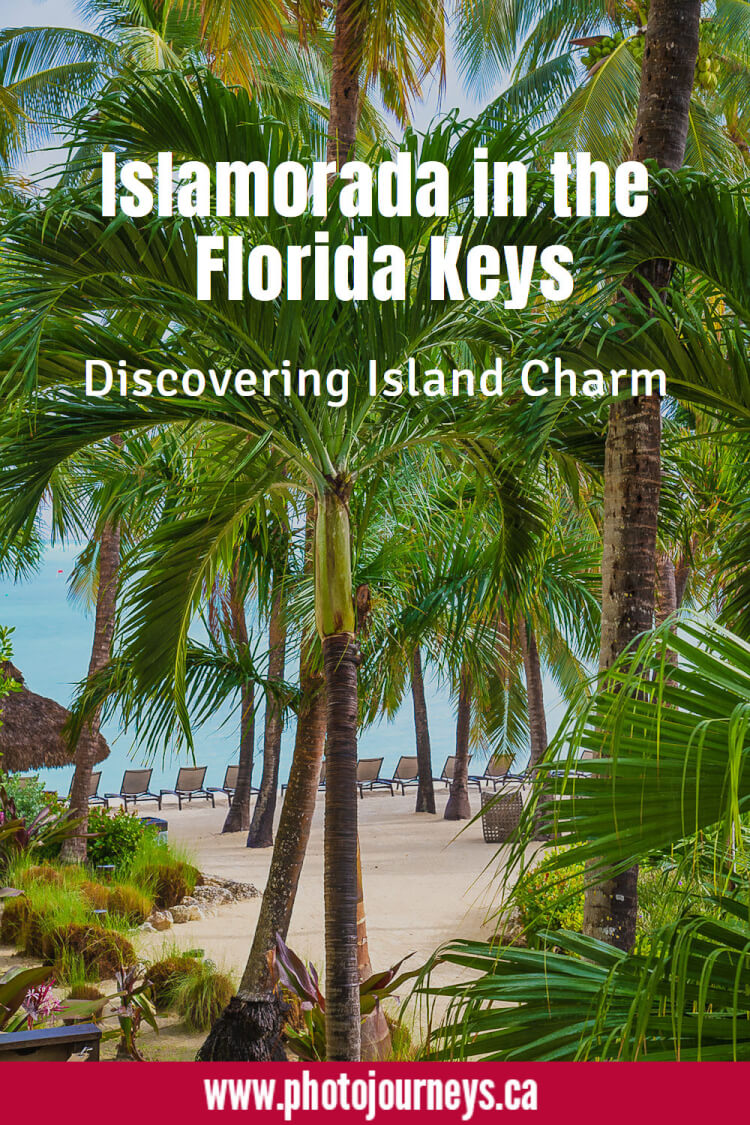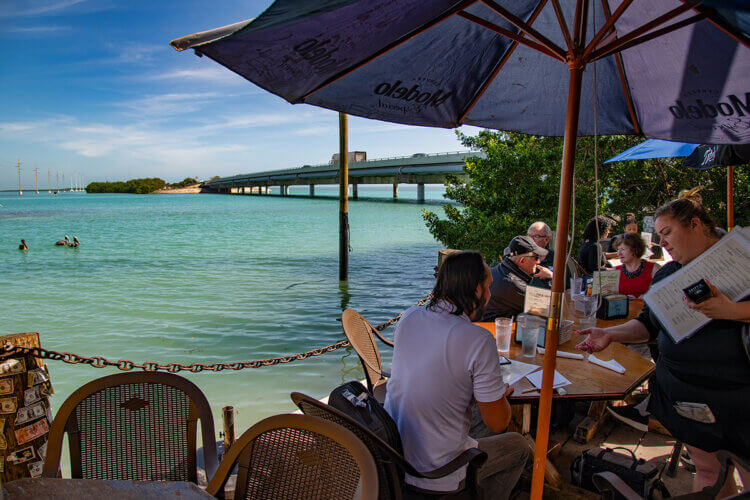
All photos © Robin and Arlene Karpan
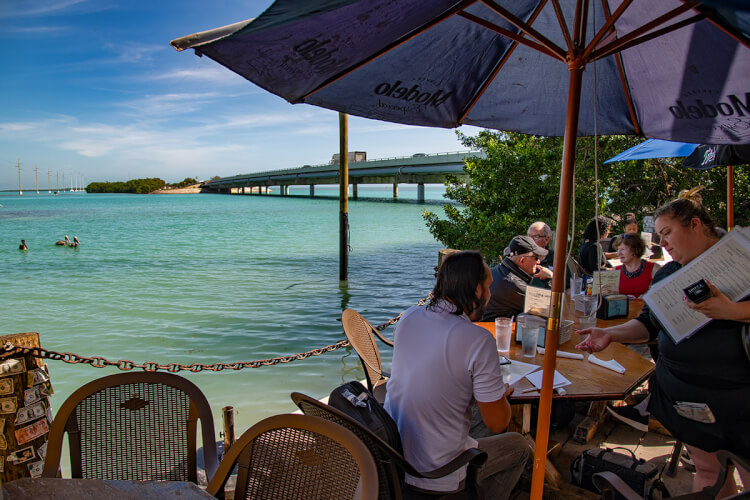
Islamorada is about a quarter the way down the long series of islands that make up the Florida Keys. The name is Spanish for Purple Island, so-called because early Spanish travelers were impressed with the vibrant purple sunsets. Rather than a single island, Islamorada refers to the name of a village comprising six islands.
Surrounded by turquoise water, the small palm-fringed sandy islands are linked together by the 113-mile long Overseas Highway running through the Keys. Long and narrow, you can walk from coast to coast, from the Atlantic Ocean to the Gulf of Mexico, in a few minutes.
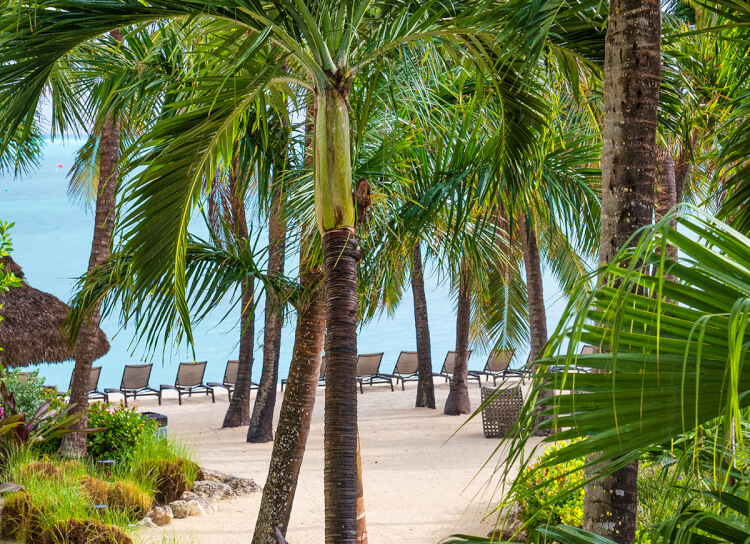
Billed as the Sport Fishing Capital of the World, Islamorada appeals to anglers who are after tarpon, sailfish, mahimahi, and others. But there’s more here than big fish. Many consider this their favourite part of the Keys because of its easy-going vibe. These are few things that caught our attention.
History of Diving Museum
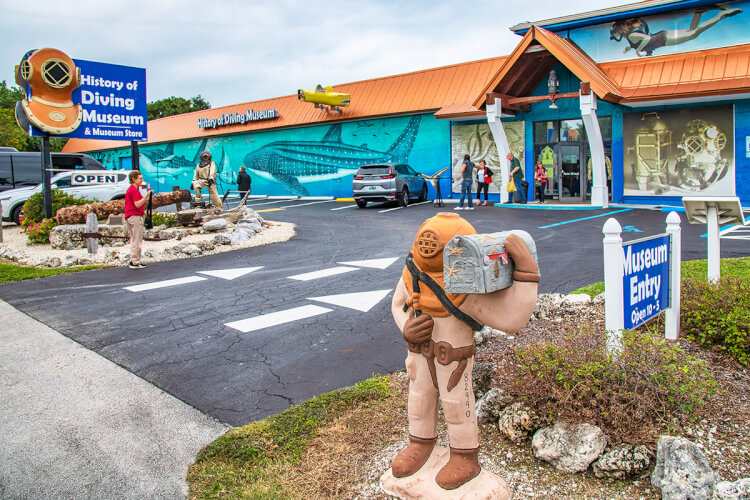
You don’t have to be a diver, or even had your head underwater, to enjoy this amazing place. It took over 40 years for Doctors Joe and Sally Bauer to amass one of the world’s largest collection of diving equipment and related artifacts.
Most fascinating were displays relating to the earliest attempts of building diving machines. For example, Edmund Halley invented the first diving helmet in the late 1600s. It was little more than a metal bucket with eye holes. There’s a display on a copper suit used for diving dating to 1797, and an array of other odd-looking contraptions.
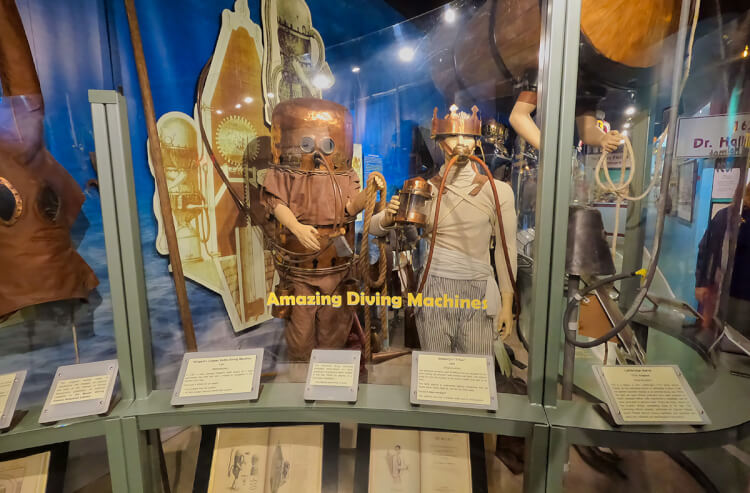
The collection includes a surprising number of homemade diving helmets, some made from fire hydrants, chamber pots and more. Years ago, Popular Mechanics magazine even published articles on how to build them. One is called the “Rum Runner”, which was used in the 1920s during Prohibition in the US. The Detroit River straddles the border between the Canada and the USA. Booze was dropped into the river on the Canadian side, and then a diver from the US side would go under water to pick up the delivery, away from prying eyes.
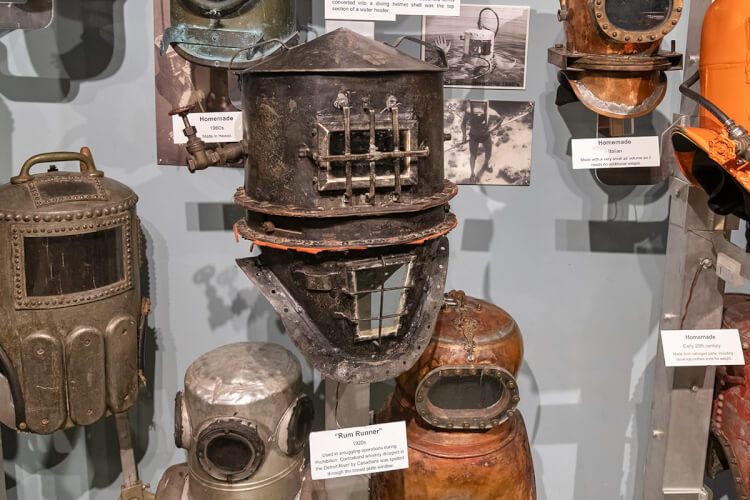
The displays take visitors throughout the development of diving, from the emergence of diving for recreation, underwater photography, SCUBA equipment, and rebreathers to recycle oxygen. One room houses the Parade of Nations with diving helmets from every country that has ever made one. A notable example is the Canadian Ice Crusher Helmet designed for breaking through ice after a long dive.
There’s even a display on Jules Verne’s novel 20,000 Leagues Under the Sea, credited with bringing diving into the public imagination in 1870.
Sunken treasure
A favourite of most visitors is Art McKee’s Treasure Room. It showcases sunken treasure collected by Art “Silver Bar” McKee, a legendary figure in the Florida Keys. Want to try your hand at lifting an actual silver bar from a wrecked Spanish ship? The 70-pound silver bar from the Atocha is protected in a specially-designed case so you can touch and feel it, and see how difficult it is to lift.
On July 15, 1733, a hurricane wrecked 17 Spanish ships carrying gold and silver treasure along the Keys from Key Largo to Vaca Key. Some artifacts are from galleon El Rubi Segundo, and you can see an actual 16th century treasure chest with an intricate locking mechanism that takes three keys to open.
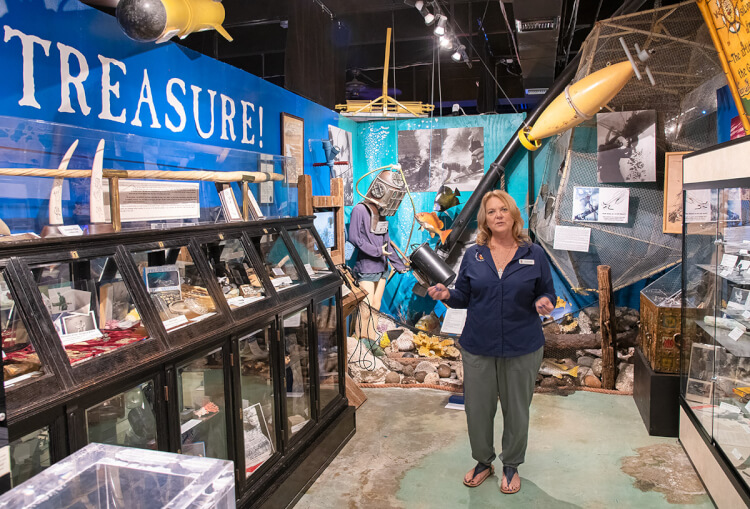
“Visitors are always surprised to learn how diving enters into everyday aspects of our lives, even though we may not see them directly,” said museum executive director Lisa Mongalia. “Divers work on bridges, in rivers and waterways, power plants, pipelines, oyster beds, in research, rescue, and so much more.” More information at History of Diving Museum.
Eating your way around Islamorada
A great way to get an introduction to the local cuisine is on a food tour. We took the Islamorada Food Tour led by Craig Zabransky. A nice thing about it was that it combined food with the history and island culture. We started at an outdoor patio where Craig brought several samples to illustrate the strong Cuban influence of the islands’ cuisine, such as traditional ham and cheese sandwiches, veggie fritters, and super strong and sweet Cuban coffee.
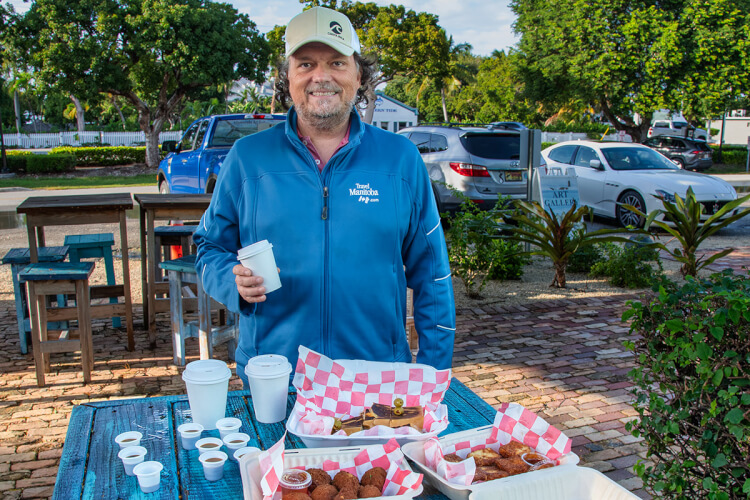
Immediately beside the patio is the Gallery of Roberto “Pasta” Pantaleo, a famous artist specializing in brilliantly colourful and larger-than-life depictions of marine life and ocean scenes. The building looks like an ordinary house from the outside, but once inside we see how it was specially built to withstand hurricanes, with exceptionally thick solid walls.
With Craig blowing on a large conch shell, we started our walking tour. This huge sea shell sounds like a trumpet in the right hands. See our article 3 Fantastic Adventures on the Water in the Florida Keys where we get into more detail on the importance of the conch in the Keys.
Craig took us for samples at some nearby restaurants, some of which rose to fame after being featured on the Food Network, especially Guy Fieri’s Diners, Drive-Ins and Dives show. We sampled shrimp fritters and coconut shrimp at the aptly named Shrimp Shack, and black grouper fish tacos at the Morada Bay Keys Beach Café where we arrived in time for sunset on the palm-lined beach.
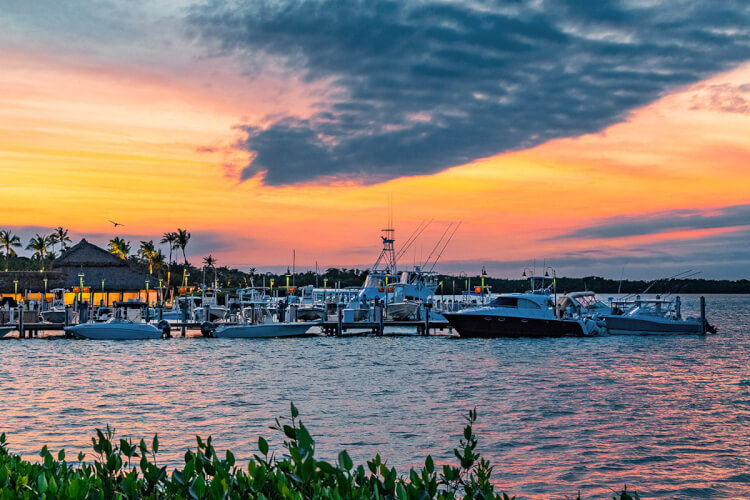
Remembering the Hurricane
A stop along our walk was at the Hurricane Memorial. Carved from local coral limestone, it is dedicated to the more than 400 people who lost their lives in the Hurricane of Sept, 2, 1935. The category 5 storm was one of the strongest ever to hit the United States. The storm surge and wall of water destroyed everything in its path.
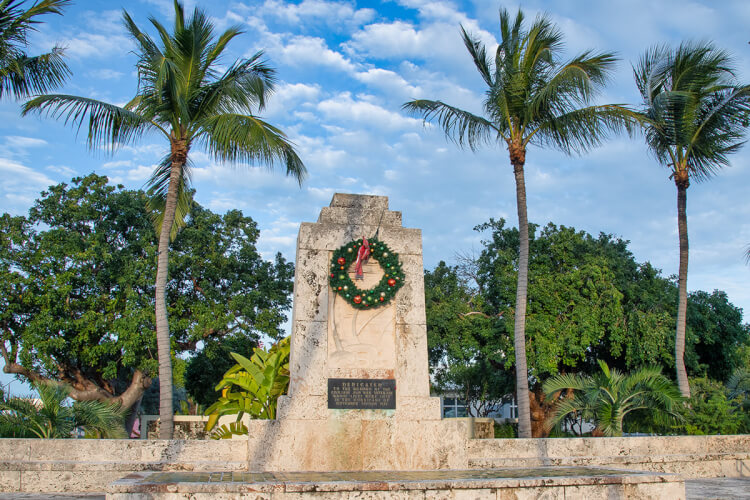
The height of the monument marks the high water level which was close to 20 feet. It’s easy to see what it would do to the pancake-flat island with no high ground. The Overseas Railway which ran through the string of islands was damaged to the point that it was never rebuilt, and was instead replaced by the Overseas Highway a few years later.
As Craig commented, “Everyone here takes hurricane warnings very seriously.”
“Livin’ the island life…drinkin’ the local beer”
That’s the slogan of the Florida Keys Brewing Company. We often like to try the local beers in our travels and, fortunately, Islamorada has some of the best. How can you resist beer with names like Iguana Bait, Funky Farmer Barrel Blend, Run Aground Brown Ale, or Jalapeno Mango Wheat Beer?
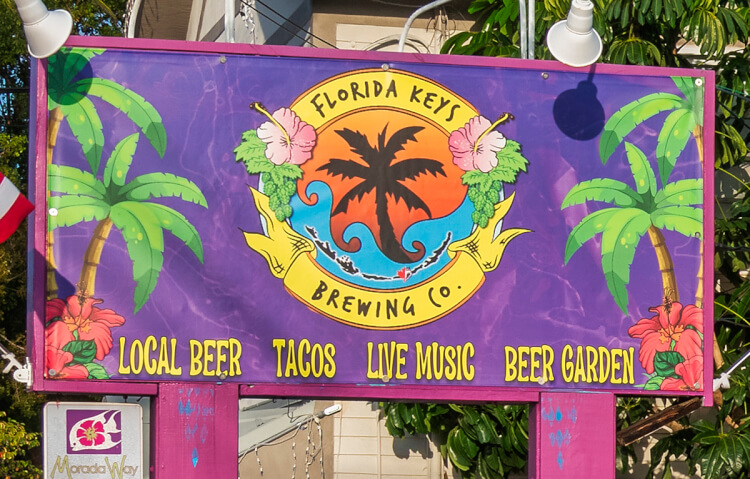
Run by Craig and Cheryl McBay, the Florida Keys Brewing Company was the first micro brewery in the Upper Keys. Craig is a Canadian transplant, originally from Ontario. Years ago he went to the Keys on a fishing trip, but ended up meeting and marrying a local gal, and stayed. Starting a brewery was not the couple’s original intention. But when Craig got a home-brewing kit as a gift, he discovered his calling and things progressed from there.
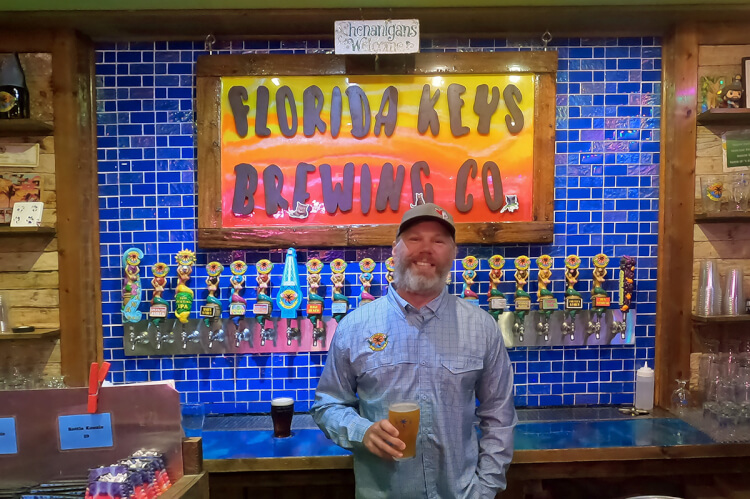
The lively tasting room for the brewery is located in the arts district of Islamorada along Highway 1, right across the street from Pasta’s Art Gallery. The first thing you notice is the riot of colour, with murals, other artwork, and huge mosaics made from bottle caps collected from around the world. While Craig looks after the beer making, Cheryl does the decorating. Live music performances often take place in the spacious and shaded outdoor beer garden just behind the tasting room.
Several beers are on tap. Ordering a flight lets you sample a selection of up to five different brews in smaller glasses. Iguana Bait is the best selling beer. It’s a traditional German-style kolsch, but complimented with honey and hibiscus (the flowers of which are the local iguanas’ favourite food). High on our list was the full-bodied Porter’s stout. Porter, by the way, doesn’t refer to a porter beer but rather the family’s dog named Porter.
Other beers have stories behind their names. Run Aground Brown gets its name from a rhyme about sailing in shallow waters such as around the Keys: “Brown, brown run aground. Blue, blue, sail on through. White, white, you might spend the night.” One of the coolest names is Pelican Poop, a special beer brewed to benefit the Florida Keys Wild Bird Center.
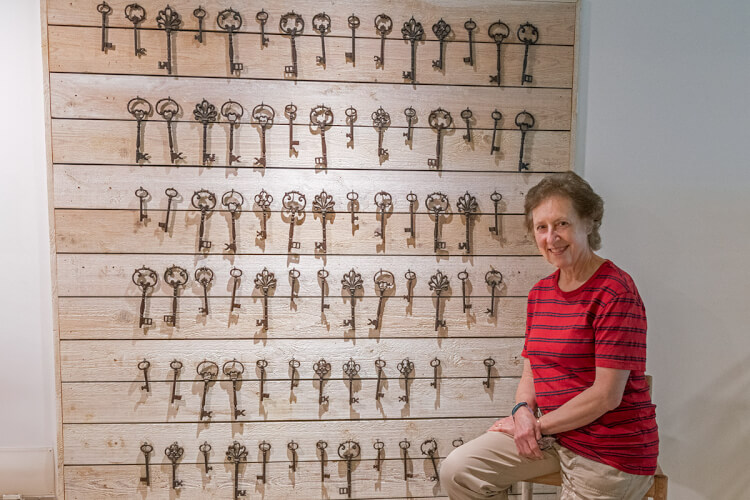
There’s a lot more in Islamorada – boat trips, diving and snorkelling, beaches, and state parks preserving nature, to mention a few. Some famous eateries include Chef Michael’s for more upscale fine dining and specializing in seafood. On the other end of the scale, Robbie’s Hungry Tarpon is as casual as it gets with a ramshackle collection of shops, a busy marina, and an ideal location to eat outdoors right on the waterfront.
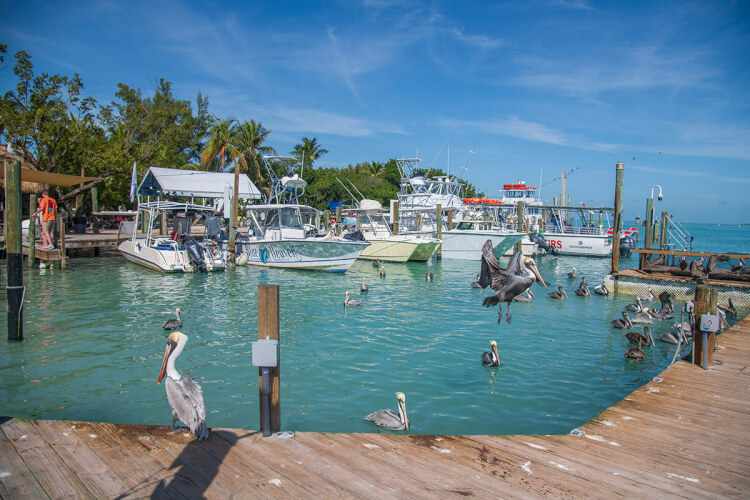
More Information
- The Florida Keys and Key West
- Key West, Florida – Surprising and Quirky by Nature on Photojourneys
- Adventures on the Water in Florida Keys on Photojourneys
SUBSCRIBE to Photojourneys below
Feel free to PIN this story on Islamorada to Pinterest
